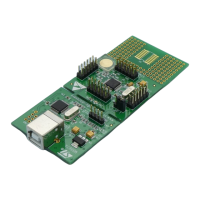RM0016 General purpose I/O ports (GPIO)
Doc ID 14587 Rev 8 105/449
11 General purpose I/O ports (GPIO)
11.1 Introduction
General purpose input/output ports are used for data transfers between the chip and the
external world. An I/O port can contain up to eight pins. Each pin can be individually
programmed as a digital input or digital output. In addition, some ports may have alternate
functions like analog inputs, external interrupts, input/output for on-chip peripherals. Only
one alternate function can be mapped to a pin at a time, the alternate function mapping is
controlled by option byte. Refer to the datasheet for a description of the option bytes.
An output data register, input data register, data direction register and two configuration
registers are associated with each port. A particular port will behave as an input or output
depending on the status of the data direction register of the port.
11.2 GPIO main features
● Port bits can be configured individually
● Selectable input modes: floating input or input with pull-up
● Selectable output modes: push-pull output or pseudo-open-drain.
● Separate registers for data input and output
● External interrupts can be enabled and disabled individually
● Output slope control for reduced EMC noise
● Alternate function I/Os for on-chip peripherals
● Input Schmitt trigger can be disabled on analog inputs for reduced power consumption
● Read-modify-write possible on data output latch
● 5 V-tolerant inputs
● I/O state guaranteed in voltage range 1.6 V to V
DDIOmax

